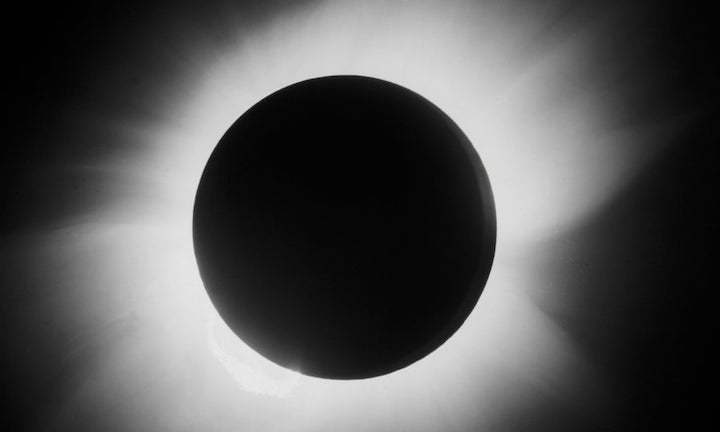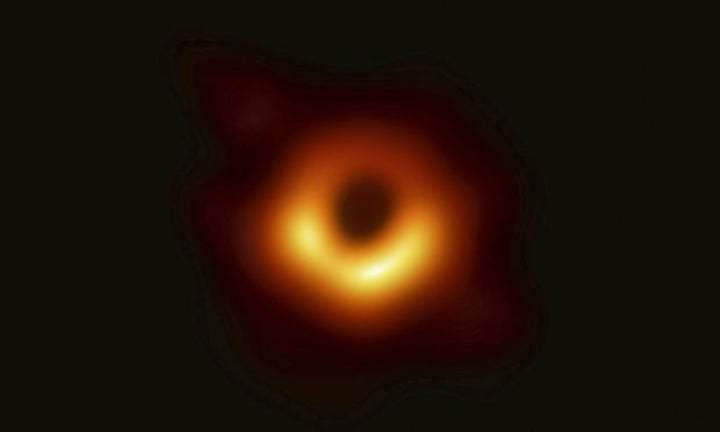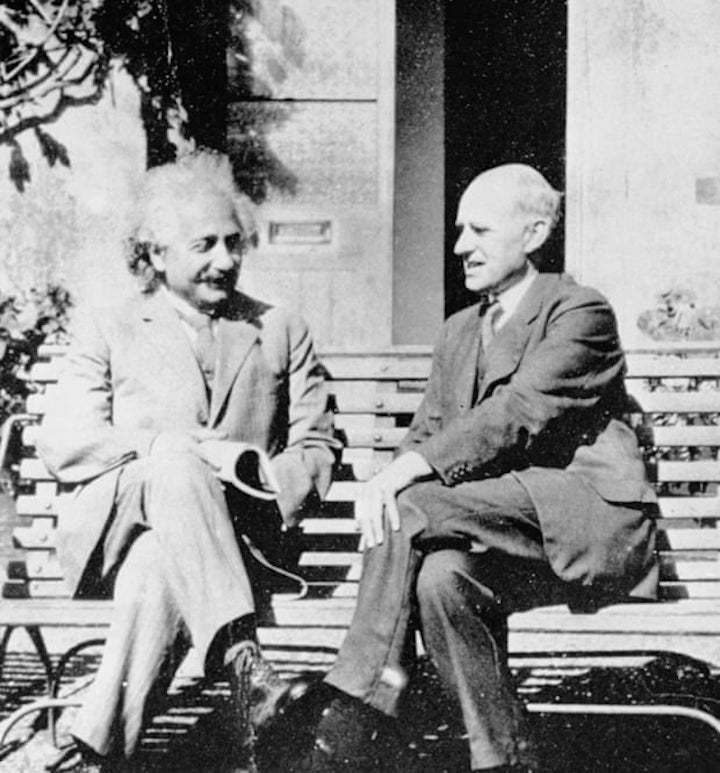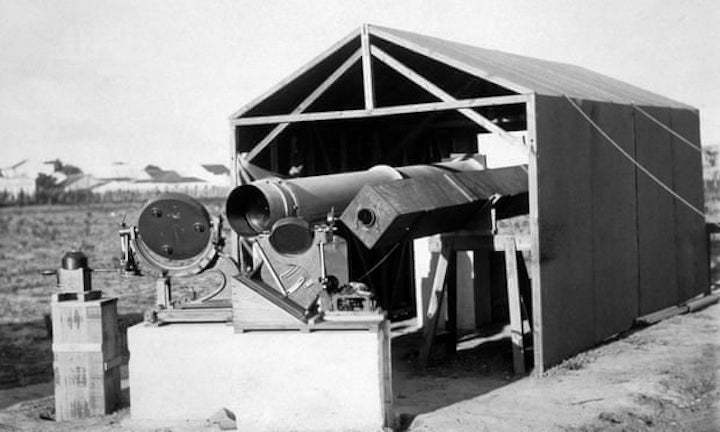12.05.2019

Total solar eclipse, 29 May 1919. Glass positive photograph of the corona, taken at Sobral in Brazil, with a telescope of 4in in aperture and 19ft focal length. Photograph: Science & Society Picture Library/SSPL via Getty Images
Arthur Eddington’s photograph of the 1919 solar eclipse proved Einstein right and ushered in a century where gravity was king
hundred years ago this month, the British astronomer Arthur Eddington arrived at the remote west African island of Príncipe. He was there to witness and record one of the most spectacular events to occur in our heavens: a total solar eclipse that would pass over the little equatorial island on 29 May 1919.
Observing such events is a straightforward business today, but a century ago the world was still recovering from the first world war. Scientific resources were meagre, photographic technology was relatively primitive, and the hot steamy weather would have made it difficult to focus instruments. For good measure, there was always a threat that clouds would blot out the eclipse.
These risks doubtless caused worries but they were well worth facing, Eddington reckoned, for he believed his observations could prove, or disprove, the most revolutionary scientific idea to have been put forward in modern science: Albert Einstein’s theory of general relativity.
In his 1915 theory, Einstein argued that gravity was not a force that acted at a distance between objects, as Isaac Newton had stated. Instead, he maintained, it was the result of an object’s mass causing space to curve. From this perspective, a body in orbit around the Sun is actually going in a straight line but through space that has been bent by the mass of the Sun. Even a beam of light would bend as it passed along this section of curved space.
“Einstein used existing astronomical observations to support his theory – for example, known anomalies in the orbit of Mercury round the Sun,” says Carolin Crawford, of the Institute of Astronomy, Cambridge. “But these were post hoc rationalisations. What was needed was a specific testable prediction to show his theory was right. The May 1919 eclipse provided that opportunity.”
During a total solar eclipse, the disc of the Moon passes in front of the Sun. This blots out its blindingly bright rays and allows astronomers to study the relatively dim light of background stars. By comparing existing photographs of a particular cluster of stars with images of them taken during an eclipse, it should be possible to discover whether the latter have shifted position because space is being bent by the Sun as it passes in front of them.
And that is what Eddington set out to prove – along with a second group of British astronomers who were sent to Sobral, in northern Brazil, which also lay under the eclipse path. Both expeditions were organised by the British astronomer royal Frank Watson Dyson and both would study stars of the Hyades cluster in the constellation Taurus – in front of which the eclipsed Sun would pass. If the apparent positions of these stars moved compared with standard, night-time photographs of the region, this would indicate that the Sun’s mass was causing space to curve.
There was one slight complication. “Newtonian physics also forecast that star positions could be shifted during an eclipse – but less so,” says Crawford. “Einstein’s theory predicted a greater deflection.”
Eddington therefore faced a daunting double problem. Could he detect any star-position changes caused by the Sun? More to the point, could he do it accurately enough to determine whether they were occurring in response to the physics of Newton or the science of Einstein? According to the former, star images would be deflected by about 0.8 of an arcsecond while Einstein said they would be moved by about 1.8 arcseconds. Given that an arcsecond is 1/3,600th of a degree, such extremely small differences would be very hard to detect.
Worse, the conditions on Príncipe turned out to be much grimmer than Eddington and his assistant Edwin Cottingham had anticipated. The pair had to work under mosquito nets and chase off monkeys which continually tried to steal bits of their equipment. “Then on the morning of 29 May, after travelling thousands of miles to view the eclipse, Eddington and Cottingham awoke to a rainstorm,” writes the author Ron Cowen in his recent history of the event: Gravity’s Century: From Einstein’s Eclipse to Images of Black Holes.
The clouds slowly cleared but there were still intermittent patches of mist in the sky when the eclipse was well under way. Eddington worked feverishly and managed to take 16 photographic plates. Later he discovered that only two of these contained enough stars to tell whether their light might have been bent or not. Finally, steamboat schedules forced them to leave Príncipe within days – without having started their measurements of the stars on the plates.
Then there were the observations taken in Sobral, in Brazil, by a second group of astronomers who were led by Andrew Crommelin and Charles Rundle Davidson of the Royal Greenwich Observatory. They experienced better observing conditions. However, to their horror they subsequently found that all 19 images they had taken with their main telescope were out of focus, the Sun’s heat having caused its mirror to expand unequally and produce blurred images. Fortunately, eight other plates taken using a smaller backup telescope produced perfect results.
The scientists gathered in August and began measuring the positions of stars on their plates. They obtained two sets of results. From the Sobral images, they found a light-bending figure of 1.98 arcseconds. From the Príncipe plates, they got a value of about 1.6.
These findings, although based on limited data, were completely in line with Einstein’s theory. It was a sensational result, one that made the event “probably the most important eclipse in history,” says the US physicist Daniel Kennefick in his book No Shadow of a Doubt: The 1919 Eclipse That Confirmed Einstein’s Theory of Relativity.
Armed with their data and analysis, the team – including Dyson, Eddington and Crommelin – stood before a packed meeting in the Royal Society in London on the evening of 6 November and outlined their results. Their audience was stunned. Two hundred years of Newtonian physics had been overturned. “This is the most important result obtained in connection with the theory of gravitation since Newton’s day,” announced the Royal Society’s president, the Nobel laureate JJ Thomson.
The world’s journalists were equally impressed. “Revolution in science: new theory of the universe: Newtonian ideas overthrown,” ran headlines in the Times the next day, while the New York Times plumped for: “Lights all askew in the heavens: Einstein’s theory triumphs.” For his part, Einstein was transformed into a global celebrity.
This was the beginning of gravity’s century – 100 years in which its warping effects on space have come to dominate astronomy. Subsequent solar eclipses also generated results entirely consistent with Einstein’s theory, while later photographs taken by the Hubble telescope have revealed even more spectacular distortions of space produced by powerful gravitational fields. In some images, starlight around massive clusters of galaxies is twisted into long stretched stripes, so mighty is the curving of space around these vast star collections.
Then, later in the century, astronomers discovered that galaxies are spinning at such speeds they should be flying apart. Some invisible form of dark matter must be providing the extra gravity to hold them together. In fact, scientists now believe there must be more than five times more dark than normal matter in the universe to explain the gravitational effects we see. Frustratingly, scientists have had no success to date in directly detecting dark matter particles.
Even more spectacular was the first detection of gravitational waves – also predicted by Einstein’s general theory of relativity. These are created when two particularly massive objects collide with each other, though Einstein thought it improbable we could detect the tiny ripples in spacetime that would be produced by these extremely distant events.
In 2016, however, astronomers announced they had detected vibrations with wavelengths measuring only a few hundred billion-billionths of a metre and concluded they had been triggered by gravitational waves set off by two black holes colliding billions of lights years from Earth.

The image of a black hole released on 10 April 2019 by the Event Horizon Telescope
And finally astronomers last month revealed they had photographed the ultimate warping of spacetime – by imaging a black hole. This is an object so dense it has curved spacetime around itself, thus preventing light from escaping from it. Taken by the Event Horizon Telescope, a global network of radio telescopes, the picture shows a black disc – the shadow of a black hole – surrounded by an orange halo produced by energised particles rotating round the black hole.
As Cowen puts it: “These two experiments – the eclipse expeditions of 1919 and the Event Horizon Telescope observations a century later – bookend an era unlike any other in the history of science.” This has been gravity’s century, in other words – a concept backed by Crawford. “The two observations – by Eddington’s team and by the Event Horizon Telescope astronomers – are perfect matches for each other. The first provides the first tantalising evidence about how gravity shapes spacetime. The latter shows how dramatic that effect can be.”
This year’s black hole image was certainly impressive. However, it was the first experiment – by Eddington – that really set things rolling and brought Einstein his fame. As Kennefick puts it: “The observation of this one eclipse … may well have been the most important scientific experiment of the entire 20th century.”
Eddington, Einstein and the first world war
Arthur Stanley Eddington was an unlikely defender of Einstein’s general relativity. For one thing, direct communication between the two men had been impossible for many years. Einstein lived in Germany which was at war with Britain when the theory of general relativity was published in 1915. Nevertheless Eddington obtained a smuggled copy and, together with the astronomer, royal Frank Dyson, began making plans to test it. Thus in the middle of the first world war, two of Britain’s most important astronomers plotted secretly to validate a German physicist’s controversial ideas. (This was a time of hatred of all things German, it should be noted. One leading academic had announced that “Germans are congenitally unfit to read our poetry” while the journal Nature had decried the inferiority of all German science.)

Einstein, left, and Eddington at the University of Cambridge Observatory, in 1930. Photograph: Royal Astronomical Society/Science Photo Library
Eddington and Dyson’s plans were nearly undone when the former, then in his early 30s and director of the Cambridge Observatory, was told his exemption from military service, as a senior academic, could no longer be tolerated. Fresh troops were desperately needed in the trenches. Eddington, a devout Quaker, refused to be considered and announced he was a conscientious objector – a claim that went down badly with his military tribunal. Only the direct intervention of Dyson – who argued that Eddington’s work was of key national importance – saved the young astronomer.
Tricks of the light: was Eddington selective with his data?
Over the past century, some science historians have questioned Eddington’s manipulation of the data his team brought back from Príncipe and Sobral. He certainly discarded images that he considered flawed and, intriguingly, these turn out to be the pictures that give light-bending figures nearer to those predicted by Newtonian physics rather than Einstein’s theory.

Instruments used to observe the 1919 total solar eclipse, Sobral, Brazil. Photograph: Science & Society Picture Library/SSPL via Getty Images
So was Eddington rigging results by ignoring inconvenient data? Did he mishandle his eclipse measurement? Some researchers have argued that this was the case – though recent re-examinations of the astronomer’s measurements do not support this conclusion. For example, in his book, No Shadow of a Doubt, Daniel Kennefick is at pains to dispel such accusations while in Nature last month, the theoretical physicist Professor Peter Coles of Maynooth University in Ireland revealed he had used modern statistical techniques to re-analyse Eddington’s data. “I’ve done this and found no evidence that Eddington ‘cooked the books’,” he stated.
Quelle: The Guardian
